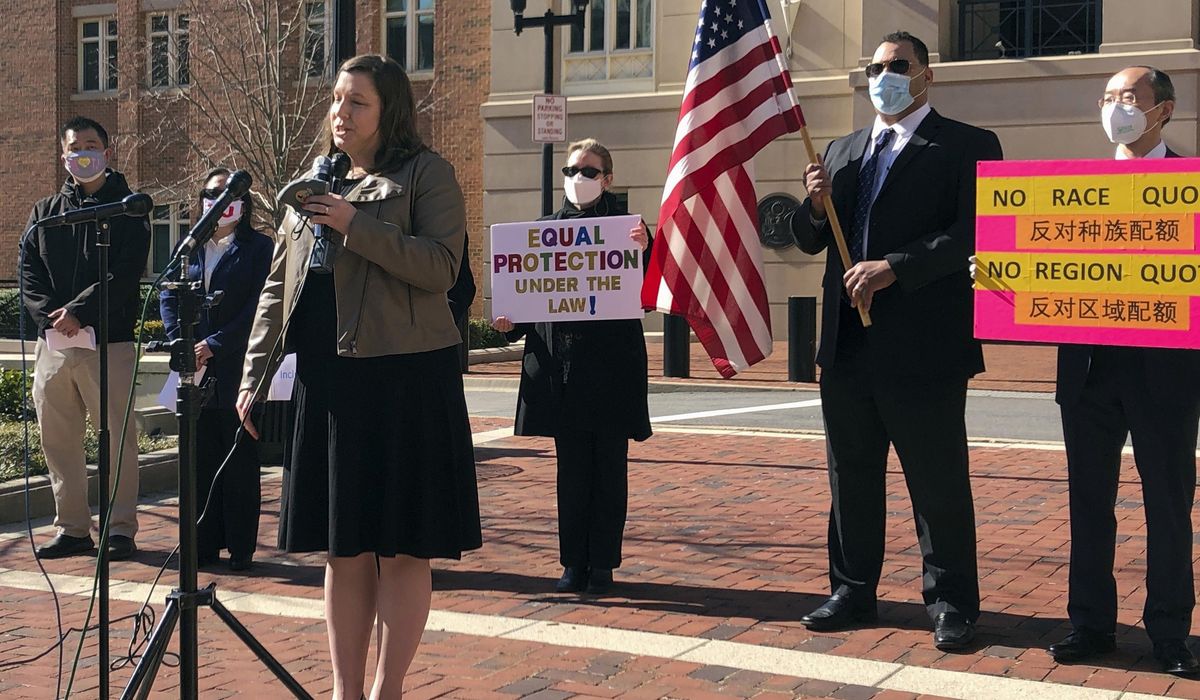


Parents and students at Thomas Jefferson High School for Science and Technology this week asked the Supreme Court to hear their challenge to the institution’s admissions policy, arguing it discriminates against Asian American students.
The request follows the Supreme Court’s June ruling striking down affirmative action at Harvard University and the University of North Carolina, where most of the justices said using race as a factor when considering a student’s application ran afoul of the Constitution.
Coalition for TJ, the group of high school families, argues the school has implemented an admissions program — like in the Harvard dispute — that disadvantages Asian American students.
The number of Asian American students at the institution fell from 73% to 54% after the admission changes.
The 4th U.S. Circuit Court of Appeals had ruled against the families challenging the policy in May just before the high court handed down its affirmative action ruling. The appeals court panel reasoned the school’s policy was neutral to race and considered other factors when admitting students, noting the board did not have discriminatory intent when changing its admissions protocol.
But the parents and students say the decision was flawed.
“This court has long recognized that a policy ‘fair on its face and impartial in appearance’ may violate the Equal Protection Clause if ‘it is applied and administered by public authority with an evil eye and an unequal hand, so as practically to make unjust and illegal discriminations between persons in similar circumstances,’” Coalition for TJ argued in its high court petition.
The group is represented by Pacific Legal Foundation. It would take four justices to vote in favor of hearing the case for the petition to be granted.
A spokesperson from Thomas Jefferson High School for Science and Technology did not immediately respond to a request for comment.
According to the legal filing, this is just one of several admissions battles pending in the courts involving K-12 school admissions.
In its 2-1 ruling in May, the 4th Circuit said Fairfax County, which runs the nationally renowned school, was trying to boost diversity among its incoming students based on geography and socioeconomic status, and any effect on the racial balance was secondary.
“On this record, and with application of the proper legal standard, the policy visits no racially disparate impact on Asian American students,” Judge Robert B. King, a Clinton appointee, wrote for the majority.
The case is part of a new trend in affirmative action law, with Asian American plaintiffs stepping forward to argue that attempts to rebalance classes with more Black or Hispanic students often come at the expense of Asian American students.
Jefferson operates as a selective school, meaning students must apply and be admitted. Anywhere from 2,500 to 3,000 students apply annually, and the school admits about 550.
The former admissions policy was based on an applicant’s grade point average, teacher recommendations, essays and a standardized test.
Asian American admissions have long been disproportionately high compared with their percentage of the population in Fairfax County.
The issue took on new proportions after a White police officer in Minneapolis killed George Floyd, a Black man, in 2020. Fairfax County began to look for ways to diversify the population at a school where the number of Black students had shrunk so much that it couldn’t be reported — meaning 10 students or fewer.
The county said part of the problem was students came heavily from a few feeder schools. So the county adopted a broader admission policy that expanded geographic and socioeconomic diversity.
The result was that Asian Americans fell from 73% of students in the class of 2024 to 55% of offers in the class of 2025.
In April, the high court let the school implement its admissions policy while the case was pending in the lower courts.
• Stephen Dinan contributed to this story.
• Alex Swoyer can be reached at aswoyer@washingtontimes.com.
